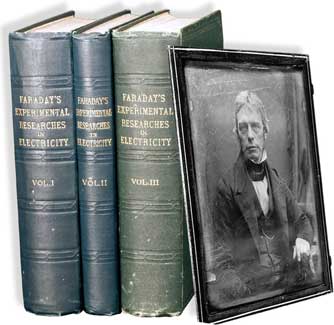| Contact |
| Back | Next | Home |
The Great Experimenter
- 1839
Michael Faraday (1791 -
1867)
|
|
This is a superb collection of first editions of many of Faraday's most important papers, including his greatest paper, Series I of Experimental Researches in Electricity, in which he demonstrates the means for generating electricity by electromagnetic induction. Each paper, article or review extracted from the journal in which it originally appeared; the collection was purchased from the distinguished science library of Haskell F. Norman.
Michael Faraday (1791 - 1867) was "one of the greatest physicists of the 19th century and one of the finest experimenters of all time. His principal contributions were made in advancing our knowledge of the nature and potentialities of electricity... he enunciated his theory of `lines' or `tubes' of magnetic force which was the starting point for, the revolutionary theories of Clerk Maxwell and later of Einstein... [his discoveries] laid the foundation of the modern electrical industry‑electric light and power, telephony, wireless telegraphy, television, etc."1 The present collection encompasses the entire range of Faraday's remarkable achievement, including his breakthrough discovery of electromagnetic induction (Phil. Trans., Series 1‑2), his first general theory of electricity as a function of interparticulate strain (Phil. Trans., Series 11‑13), and his last major series of researches on magnetism (Phil. Trans., Series 19‑21) "containing the germ of modern field theory," from which Clerk Maxwell and .Einstein developed their own theories6.
|
|
Including Faraday's greatest paper, reporting his discovery of the means for generating electricity by electro-magnetic induction. "Faraday became convinced that the relation of electricity to magnetism had to be extended, and that if a current could produce a magnetic field, a magnetic field also had to be able to produce a current. . . . Faraday brooded over [this problem] for about ten years, and made numerous experiments, all negative. . . . In the summer [of 1831], he built an iron ring on which he wrapped two coils of copper wire. He then noted that if he sent a current in one and connected the other to a galvanometer, the instrument would signal a current not in the stationary state, but only at the establishment or interruption of a current in the other coil. That was the clue he needed. By the end of September he had developed a clear understanding and experimental demonstration of electromagnetic induction. He had grasped the vital point that to generate a current, a conductor had to cut the lines of magnetic force. . . . Once the nature of electromagnetic induction was understood, Faraday was able to explain Arago's observations and to invent an electromagnetic generator of currents—a primitive dynamo" (Segrè, Falling Bodies to Radio Waves, pp. 143-44; also 132-55). Dibner 64. Horblit 29 (citing 1839 book-form reprint). Williams, Michael Faraday, pp. 137-90; 200-201. Jeffreys 187. 32209
The other extracts gathered here, 102 from Quarterly Journal of Science, 1816‑30, and 13 extracts from Annals of Philosophy, 1821‑26, include Faraday's first published paper, "Analysis of the native caustic Lime" (QJS, 1816); his 1825 paper announcing the discovery of benzene; his early "Historical Sketch of Electro‑magnetism" (1821), requested by editor Richard Phillips and contributed anonymously; his groundbreaking 1821 paper "On some new Electro‑Magnetical Motions, and the Theory of Magnetism," which records the first conversion of electrical into mechanical energy‑this paper also contains the first notion of the line of force (DSB)‑and three important follow‑up papers from the same year. The 30 Series of Experimental Researches in Electricity were collected in book form in three volumes dated 1839, 1844 and 1859, after the papers appeared in Philosophical Transactions. Series 3‑10, not collected here, deal primarily with electrochemistry, in which Faraday demonstrates the common identity of all forms of electricity; Series 23‑30, also not collected here, elaborate further on his earlier revolutionary discoveries.10 The other extracts gathered here, 102 from Quarterly Journal of Science, 1816‑30, and 13 extracts from Annals of Philosophy, 1821‑26, include Faraday's first published paper, "Analysis of the native caustic Lime" (QJS, 1816); his 1825 paper announcing the discovery of benzene; his early "Historical Sketch of Electro‑magnetism" (1821), requested by editor Richard Phillips and contributed anonymously; his groundbreaking 1821 paper "On some new Electro‑Magnetical Motions, and the Theory of Magnetism," which records the first conversion of electrical into mechanical energy‑this paper also contains the first notion of the line of force (DSB)‑and three important follow‑up papers from the same year. The 30 Series of Experimental Researches in Electricity were collected in book form in three volumes dated 1839, 1844 and 1859, after the papers appeared in Philosophical Transactions. Series 3‑10, not collected here, deal primarily with electrochemistry, in which Faraday demonstrates the common identity of all forms of electricity; Series 23‑30, also not collected here, elaborate further on his earlier revolutionary discoveries.10
| Contact |
| Back | Next | Home |
